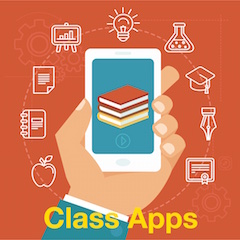The First 5 Minutes: Ignite Student Learning
A MiddleWeb Blog
I have a teaching colleague who was a very talented track and field athlete back in the day. In one of our recent conversations about teaching and learning, she shared a bit of “sprinter wisdom” that is making a notable difference in my classroom.
She explained —
“Great lessons are a lot like running the 100-meter dash—a strong start makes all the difference.”
Most educators would agree that – when done well – the opening minutes of class have the potential to ignite a ‘wildfire’ of engagement and effort among our students. But a poor start – one that fails to pique learners’ interest, establish real-world relevance or engage students in authentic, challenging learning tasks – is akin to trying to start a fire with wet matches and kindling.
I’m going to suggest some ways we can blend tech into effective “class starters,” but first a quick look at the research.
Research-based recommendations for starting class
Getting the absolute most out of the first few moments of class requires careful planning and purposeful implementation (Slater, 2006). For instance, students are more likely to engage in learning when the learning intentions – sometimes described as ‘learning goals’ or ‘anticipated outcomes’ – are made clear (McClune & Jarman, 2011).
Learning intentions are even more powerful when they (1) connect previous learning to the new; (2) identify content and skills to be mastered, and (3) assist students in monitoring their own learning (Dean & Marzano, 2013).
Really powerful essential questions can also be used at the beginning (and throughout) class to foster interest, thinking, energy, and effort. Think of them as clothes hangers that the day’s content, vocabulary, thinking skills, learning tasks, and assessments can all be hung upon.
For example, How does where you live influence how you live? Or…How can a diet that is healthy for one person be unhealthy for another? Such questions require students to deepen their thinking, connect concepts together, and relate them to the real world (McTighe & Wiggins, 2013).
Another research-proven approach is to utilize an ‘engagement hook,’ or initial activity designed by the teacher to foster student curiosity and creative thinking in connection to learning activities that will follow.

For some great tips and ideas on how to design an effective engagement hook, check out this post by Jennifer Gonzalez and part II of Dave Burgess’ (2012) unorthodox but wildly entertaining book, Teach Like a Pirate.
Tools to capitalize on the first 5 minutes
In recent posts, I’ve already shared a few ideas about using polling tools, challenging problems, and even video clips to kick off class. But over the past few weeks, I visited with colleagues and students to compile a longer list of activities and tools to help all of us get class off to strong start.
►Virtual Messages
There are a number of simple sites/apps such as ChatterPix and Blabberize that make it easy for teachers to upload pictures and make them ‘talk’ to students. One of my favorite sites continues to be Voki. It only takes a couple of minutes to create a realistic looking character that speaks to your class and introduces the day’s learning goals, topic or assignments.
For example, I recently used this quick video with my students to introduce a civilization activity called ‘Can You Save the World?’
Students were told (by an alien) that our planet was going to be taken over and that we would all be eaten…unless, of course, we could gather convincing evidence that we were actually civilized.
Using what they already had learned about culture and society, students worked in teams to define the term ‘civilization’ and to create criteria that could be used to differentiate between uncivilized and civilized species. The next two days we spent gathering up evidence of our own ‘civilized nature’ in the form of artifacts, news articles and argumentative writing.
►Simulations
Some learning goals lend themselves very well to the use of “simulations” or controlled experiences deigned to resemble situations in the real world (Hattie, 2009). For example, Glenn Wiebe’s HistoryTech website has a fantastic list of online simulations geared towards Social Studies. For math and science teachers, there is PhET, a site with tons of free, interactive, content-specific simulations sorted by topic and grade level.
►Current events, real-world problems, and mild controversy
Not too long from now, our students will be working to resolve many of the difficulties that we adults have helped to create. It makes sense, therefore, to lead them to knowledge about real-world problem solving, and let them practice wrestling with controversies like those they will encounter in the world outside of the classroom.
A while back, I wrote a post on several tools that connect to the news. TweenTribune, ListenWise, and Newsela’s PRO/CON articles introduce students to current events and include a few mildly controversial topics. Student access to the news, however, is not enough to foster learning.
Teachers must work strategically to develop, introduce, and execute learning activities that help students move beyond emotional decision-making and instead develop objectivity and critical thinking.
One of my student’s favorite, start-of-class activities combines incredible photos from sites like BBC in Pictures, Time or NYT Year in Pictures with a slightly controversial and/or ambiguous question. For example, displaying a picture of Sudanese refugees who have fled their country due to violence and fighting, then asking students to reflect on ‘Whose responsibility is it to help them?’
►You Don’t Have to Use Tech
It is important to remember that ‘no-tech’ simulations can be as powerful as ‘high-tech’ ones. I was in a class recently where a 6th grade teacher was introducing his class to the development of the factory system and rise of the Industrial Revolution.
As soon as students entered the classroom, he assigned them to work at either the ‘skilled craftsman’ table or the ‘assembly line’ table. Students were then challenged to build as many ‘Perfect Mr. Potato Heads’ as they could in 4 minutes.
Individuals at the ‘skilled craftsmen’ table worked alone to make each one from start to finish, while those at the ‘assembly line’ worked in a consecutive link where they only did one small part repeatedly before handing it on to the next person on the assembly line.
Afterwards, students reflected on and analyzed how assembly lines and other technological innovations likely impacted the American labor force and economy. Talk about a-ha moments!
Better Beginnings = Sustained Learning
I suspect that few of us spend enough time planning out ways to use the beginning of class to ignite student learning. We develop learning goals, assessments, activities and much, much more. It would be a shame to do all that work only to have our students putter out before we even really get started.
If we are truly working to improve student learning and outcomes, it’s time to devote a bit more attention the first five minutes of class. That’s about how long it takes students to decide how much interest and energy they will devote to the learning activities, assessments, or whatever else is to follow.
My runner friend was right — a strong start is likely to make all the difference.







































Thanks for sharing and for including links to ideas and resources we can research for the classes we currently teach. These ideas work well in college courses, too.
Excellent article. Thanks for sharing the ideas and links that can be used in the classroom.
Excellent article; full of good ideas, and good reminders to improve learning outcomes. thanks!!
Well spoken. It’s not very easy to get the learners’ attention. That could be done by putting ourselves into learners’ context. Even a journey of a thousand miles starts with baby steps. Introduction is very important.